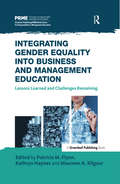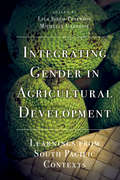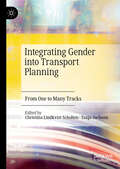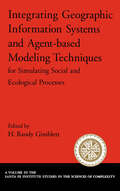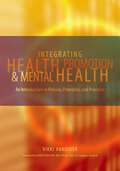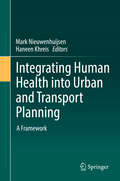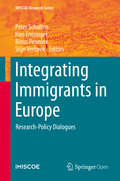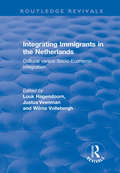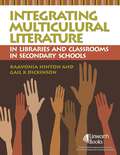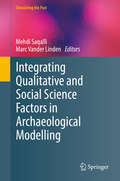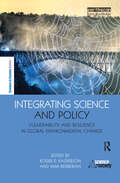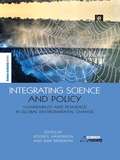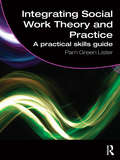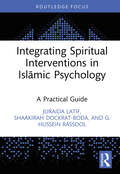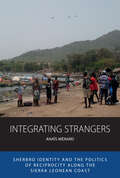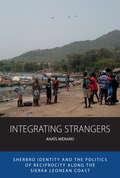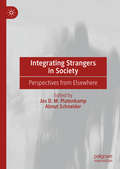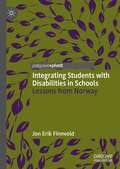- Table View
- List View
Integrating Gender Equality into Business and Management Education: Lessons Learned and Challenges Remaining
by Patricia M. Flynn Kathryn Haynes Maureen A. KilgourThis volume addresses the need to integrate gender equality into business and management education and provides examples of leading initiatives illustrating how this can occur from various disciplinary and global perspectives. Gender inequality has a long history in business schools and the workplace, and traditions are hard to change. Some disciplines remain resolutely gendered, affecting both women and men; and case materials on women leaders and managers are still rare.The chapters provide conceptual and research rationales as to why responsible management education must address the issue of gender equality. They also identify materials and resources to assist faculty in integrating gender issues and awareness into various disciplines and fields. These include specific case studies and innovations that assess or address the role of gender in various educational environments.The book is designed to help faculty integrate the topic of gender equality into their own teaching and research and gain support for the legitimacy of gender equality as an essential management education topic. This is the first book in a series on gender equality as a challenge for business and management education, published with the Principles of Responsible Management Education (PRME) Working Group on Gender Equality.
Integrating Gender Equality into Business and Management Education: Lessons Learned and Challenges Remaining
by Kathryn Haynes Patricia M. Flynn Maureen A. KilgourThis volume addresses the need to integrate gender equality into business and management education and provides examples of leading initiatives illustrating how this can occur from various disciplinary and global perspectives. Gender inequality has a long history in business schools and the workplace, and traditions are hard to change. Some disciplines remain resolutely gendered, affecting both women and men; and case materials on women leaders and managers are still rare.The chapters provide conceptual and research rationales as to why responsible management education must address the issue of gender equality. They also identify materials and resources to assist faculty in integrating gender issues and awareness into various disciplines and fields. These include specific case studies and innovations that assess or address the role of gender in various educational environments.The book is designed to help faculty integrate the topic of gender equality into their own teaching and research and gain support for the legitimacy of gender equality as an essential management education topic. This is the first book in a series on gender equality as a challenge for business and management education, published with the Principles of Responsible Management Education (PRME) Working Group on Gender Equality.
Integrating Gender in Agricultural Development: Learnings from South Pacific Contexts
by Lila Singh-Peterson Michelle CarnegieSouth Pacific island nations are committed to international agreements and regional declarations to progress gender equality within their own territories, yet progress towards Sustainable Development Goal 5, Gender Equality, has been reported as slow and uneven. Tackling persistent gender inequalities in agriculture has been identified as a priority due to the industry's commercial importance to economies and communities across the region, and its role in food security. This book is grounded in the ideology that an alignment between the conceptual and practical understandings of gender equality is a critical component of sustainable development. Two introductory chapters establish the book's broader context. The following chapters draw on six rural case studies from Melanesia (Vanuatu, Fiji and Papua New Guinea) and Polynesia (Samoa and Tonga) across cropping, livestock, horticulture and aquaculture sectors to examine the various ways in which gender has been integrated in agricultural research for development projects. The case study authors explore the opportunities and challenges involved in integrating or mainstreaming gender, from research design to implementation, and reflect on the lessons learned. The final chapters synthesise these shared, field-based learnings and positions them within contemporary gender concepts to contribute to an understanding of how they are translated in practice to diverse South Pacific contexts.
Integrating Gender in Agricultural Development: Learnings from South Pacific Contexts
by Lila Singh-Peterson Michelle CarnegieSouth Pacific island nations are committed to international agreements and regional declarations to progress gender equality within their own territories, yet progress towards Sustainable Development Goal 5, Gender Equality, has been reported as slow and uneven. Tackling persistent gender inequalities in agriculture has been identified as a priority due to the industry's commercial importance to economies and communities across the region, and its role in food security. This book is grounded in the ideology that an alignment between the conceptual and practical understandings of gender equality is a critical component of sustainable development. Two introductory chapters establish the book's broader context. The following chapters draw on six rural case studies from Melanesia (Vanuatu, Fiji and Papua New Guinea) and Polynesia (Samoa and Tonga) across cropping, livestock, horticulture and aquaculture sectors to examine the various ways in which gender has been integrated in agricultural research for development projects. The case study authors explore the opportunities and challenges involved in integrating or mainstreaming gender, from research design to implementation, and reflect on the lessons learned. The final chapters synthesise these shared, field-based learnings and positions them within contemporary gender concepts to contribute to an understanding of how they are translated in practice to diverse South Pacific contexts.
Integrating Gender into Transport Planning: From One to Many Tracks
by Christina Lindkvist Scholten Tanja JoelssonThis edited collection brings together feminist research on transport and planning from different epistemologies, with the intention to contribute to a more holistic transport planning practice. With a feminist perspective on transport policy and planning, the volume insists on the political character of transport planning and policy, and challenges gender-blindness in a policy area that impacts the everyday lives of women, men, girls, and boys. The chapters discuss everyday mobility as an embodied and situated activity in both conceptual and theoretical ways and suggest practical tools for change. The contributions of this collection are threefold: integrating gender research and transport planning, combining quantitative and qualitative gender research perspectives and methods, and highlighting the need to acknowledge the politicization of transport planning and transport practice.
Integrating Geographic Information Systems And Agent-based Modeling Techniques For Simulating Social And Ecological Processes
by H. Randy GimblettIntegrating Geographic Information Systems and Agent-Based Modeling Techniques for Simulating Social and Ecological Processes (Santa Fe Institute Studies on the Sciences of Complexity)
by H. Randy GimblettThis volume presents a set of coherent, cross-referenced perspectives on incorporating the spatial representation and analytical power of GIS with agent-based modelling of evolutionary and non-linear processes and phenomena. Many recent advances in software algorithms for incorporating geographic data in modeling social and ecological behaviors, and successes in applying such algorithms, had not been adequately reported in the literature. This book seeks to serve as the standard guide to this broad area.
Integrating Health Promotion and Mental Health: An Introduction to Policies, Principles, and Practices
by Vikki L. VandiverMental health systems are in a crucial transition period, thanks to the increasing prominence of health promotion theory and a corresponding shift toward emphasizing wellness and empowerment, holistic and family-friendly design, and empirically supported treatment. Such changes demand adjustments to mental health education, and re-education, to maintain a common ground among students, specialists, and providers. The first book of its kind, Integrating Health Promotion and Mental Health presents a seamless framework for approaching contemporary mental health problems. In this informative and engaging text, healthcare expert Vikki L. Vandiver shows how mainstream mental health services can realistically begin to utilize health promotion principles. Vandiver begins by approaching the need for mental health reform based on stakeholder perspectives and providing an overview of the history and practice of health promotion, leading into a discussion of how health promotion practices can be incorporated into evidence-based mental health treatments, particularly those for women with co-morbid health and mental health conditions and children with mental health needs. Finally, Vandiver offers an articulate summary and critique that sheds light on how mental health administrators can incorporate health promotion concepts and practices in their organizations in a strategic, culturally competent manner. Driven by theory and the most recent data, Vandiver's writing is also eminently accessible; the pages are rich with conceptual diagrams, case examples, and testimonies from mental health consumers. Integrating Health Promotion and Mental Health will help specialists, researchers, and students alike in fields such as public health, nursing, social work, health psychology, psychiatric rehabilitation, and counseling to comprehend the basics of health promotion and how they can lead to new and more effective practice models.
Integrating Human Health into Urban and Transport Planning: A Framework
by Mark Nieuwenhuijsen Haneen KhreisThis volume brings together the world’s leading experts on urban and transport planning, environmental exposures, physical activity, health and health impact assessment to discuss challenges and solutions in cities. The book provides a conceptual framework and work program for actions and outlines future research needs. It presents the current evidence-base, the benefits of and numerous case studies on integrating health and the environment into urban development and transport planning. Within cities there is a considerable variation in the levels of environmental exposures such as ambient air pollution, noise, and temperature, green space availability and physical activity. Many of these exposures, and their adverse health impacts, are related to and are being exacerbated by urban and transport planning and policy. Emerging research suggests that urban and transport planning indicators such as road network, distance to major roads, traffic density, household density, industry, and natural and green space can explain a large proportion of the variability in environmental exposures and therefore represent important and highly modifiable factors. The urban environment is a complex interlinked system. Decision-makers need not only better data on the complexity of factors in environmental and developmental processes affecting human health, but also an enhanced understanding of the linkages between these factors and health effects to determine at which level to target their actions most effectively. In recent years, there also has been a shift from trying to change at the national level to more comprehensive and ambitious actions being developed and implemented at the regional and local levels. Cities have come to the forefront of providing solutions for environmental issues such as climate change, which has co-benefits for health, but yet need better knowledge for wider health-centric action. This book provides the latest and most up-to-date information and studies for academics and practitioners alike.
Integrating Immigrants in Europe: Research-Policy Dialogues (IMISCOE Research Series)
by Peter Scholten Han Entzinger Rinus Penninx Stijn VerbeekThis open access book explores how research and policymaking in the field of migrant integration have developed historically and how this interrelationship plays out in the strongly politicised climate of opinions on migration in Europe. It features interdisciplinary theoretical contributions as well as original empirical studies on research-policy dialogues at both the EU and country level.The chapters study not only how the dialogue between research and policy is structured (such as advisory bodies, research agencies, and ad-hoc committees), but also how these dialogues affect policymaking and the development of migrant integration research itself as well.The analysis reveals profound changes in the dialogue structures associated with the research-policy nexus in the domain of migrant integration. On the one hand, dialogue structures have become more ad-hoc, often established in response to distinct political events or to specific problems. On the other, politicisation has not thwarted all efforts to develop more institutionalised dialogue structures between producers and users of knowledge. In addition, research has contributed to policymaking in very different ways in various European countries.This edited volume is unique in this effort to reflect on the impact of research-policy dialogues both on the development of migrant integration policies as well as on migrant integration research. It will be of importance to scholars in this field as well as to policymakers and other stakeholders involved in migrant integration policymaking.
Integrating Immigrants in the Netherlands: Cultural Versus Socio-Economic Integration
by Louk Hagendoorn Justus Veenman Wilma VolleberghThis title was first published in 2003. Using a behaviourist and quantitative approach, this study examines the vexed questions surrounding the economic and cultural integration of immigrants into the Netherlands. The authors use the Dutch case as a specific example of a wider European problem. The book examines the two opposing theoretical and political points of view on integration, whether immigrants need to adapt to the dominant culture before they are able to fully participate in socio-economic life, or whether as they participate in socio-economic life they will gradually adapt to the dominant culture. Based primarily on quantitative research, the authors unravel the complex interrelationship between cultural and socio-economic integration. They explore some of the barriers to entry into Dutch society and discuss questions of ethnic identification, parenting, educational achievement and the labour market. Since contextual factors clearly affect integration, the study also looks at the effects of migrant policies and immigration policies in different West European countries and examines social distance from immigrant groups by the native Dutch population.
Integrating Immigrants in the Netherlands: Cultural Versus Socio-Economic Integration
by Wilma Vollebergh Justus Veenman Louk HagendoornThis title was first published in 2003. Using a behaviourist and quantitative approach, this study examines the vexed questions surrounding the economic and cultural integration of immigrants into the Netherlands. The authors use the Dutch case as a specific example of a wider European problem. The book examines the two opposing theoretical and political points of view on integration, whether immigrants need to adapt to the dominant culture before they are able to fully participate in socio-economic life, or whether as they participate in socio-economic life they will gradually adapt to the dominant culture. Based primarily on quantitative research, the authors unravel the complex interrelationship between cultural and socio-economic integration. They explore some of the barriers to entry into Dutch society and discuss questions of ethnic identification, parenting, educational achievement and the labour market. Since contextual factors clearly affect integration, the study also looks at the effects of migrant policies and immigration policies in different West European countries and examines social distance from immigrant groups by the native Dutch population.
Integrating Multicultural Literature in Libraries and Classrooms in Secondary Schools
by KaaVonia Hinton Gail K. DickinsonReach students across all cultures with multicultural literature! Help all students learn to read, comprehend, and gain information literacy skills through multicultural literature. Use this book to provide hands-on instruction to help students connect, learn, and achieve Adequate Yearly Progress (AYP)! Sample standards-based, integrated lesson plans and curriculum units show teachers how to really integrate multicultural materials in their lessons to help all students achieve. This is an excellent resource for teachers and librarians who teach and motivate English Language Learners (ELL) and students from all cultures.
Integrating Qualitative and Social Science Factors in Archaeological Modelling (Computational Social Sciences)
by Mehdi Saqalli Marc Vander LindenThis book covers the methodological, epistemological and practical issues of integrating qualitative and socio-anthropological factors into archaeological modeling. This text fills the gap between conceptual modeling (which usually relies on narratives describing the life of a past community) and formalized/computer-based modeling which are usually environmentally-determined. Methods combining both environmental and social issues through niche and agent-based modeling are presented. These methods help to translate data from paleo-environmental and archaeological society life cycles (such as climate and landscape changes) into the local spatial scale. The epistemological discussions will appeal to readers as well as the resilience socio-anthropological factors provide facing climatic fluctuations. Integrating Qualitative and Social Science Factors in Archaeological Modelling will appeal to students and researchers in the field.
Integrating Science and Policy: Vulnerability and Resilience in Global Environmental Change
by Roger E KaspersonAs progress towards a greater knowledge in sustainability science continues, the question of how better to integrate scientific progress with actual decisions made by practitioners remains paramount. This book aims to help close the gap between science and practice. Based on a two year collaborative project between Harvard and Clark Universities, the book takes as its focus the vulnerability and resilience of people around the world to the effects of environmental change, a mature area of research in which one might expect the gap between science and policy/practice to have been extensively bridged. The book presents analysis of past studies, interviews conducted with the producers and users of scientific knowledge, and case studies performed by leading scholars across a spectrum of international settings and political systems. Crucially, the authors identify new directions and tools for closing the gap between science and policy across a range of situations and societies. The result is an illuminating collection of studies and analyses that suggest to researchers, students, practitioners, and policy-makers alike how best to ensure that high quality environmental research informs good environmental policy and practice. ACKNOWLEDGEMENTS The editors and authors are grateful to Lu Ann Pacenka, who formatted the text of the book.? The editors also wish to express their appreciation to Bill Clark and Nancy Dickson of Harvard University, who commissioned and provided oversight for the preparation of the volume.? Both editors and authors wish to express their appreciation to the David and Lucile Packard Foundation for providing funds to support the project.? Finally, the editors are grateful for the continuing support of the George Perkins Marsh Institute at Clark University. Published with Science in Society
Integrating Science and Policy: Vulnerability and Resilience in Global Environmental Change
by Roger E KaspersonAs progress towards a greater knowledge in sustainability science continues, the question of how better to integrate scientific progress with actual decisions made by practitioners remains paramount. This book aims to help close the gap between science and practice. Based on a two year collaborative project between Harvard and Clark Universities, the book takes as its focus the vulnerability and resilience of people around the world to the effects of environmental change, a mature area of research in which one might expect the gap between science and policy/practice to have been extensively bridged. The book presents analysis of past studies, interviews conducted with the producers and users of scientific knowledge, and case studies performed by leading scholars across a spectrum of international settings and political systems. Crucially, the authors identify new directions and tools for closing the gap between science and policy across a range of situations and societies. The result is an illuminating collection of studies and analyses that suggest to researchers, students, practitioners, and policy-makers alike how best to ensure that high quality environmental research informs good environmental policy and practice. ACKNOWLEDGEMENTS The editors and authors are grateful to Lu Ann Pacenka, who formatted the text of the book.? The editors also wish to express their appreciation to Bill Clark and Nancy Dickson of Harvard University, who commissioned and provided oversight for the preparation of the volume.? Both editors and authors wish to express their appreciation to the David and Lucile Packard Foundation for providing funds to support the project.? Finally, the editors are grateful for the continuing support of the George Perkins Marsh Institute at Clark University. Published with Science in Society
Integrating Social Work Theory and Practice: A Practical Skills Guide
by Pam Green ListerAll social work students study theory and undertake practice placements. Integrating the two – so that each informs the other – is both essential and notoriously tricky. This accessible book demystifies the process and offers helpful evidence-based strategies for doing it successfully. Structured around different approaches to learning, Integrating Social Work Theory and Practice covers: Adult and student centred learning Learning and teaching techniques and assessment methods How to locate and identify theory How to critically analyse theory Key theoretical concepts in social science Issues surrounding anti-oppressive theory and practice Methods of intervention Integrating theory and practice in academic work and on placements. This essential text helps students to identify, critically analyse and apply theory appropriately, enhancing their practice. It will be useful to all social work students struggling with the theory-practice gap.
Integrating Social Work Theory and Practice: A Practical Skills Guide
by Pam Green ListerAll social work students study theory and undertake practice placements. Integrating the two – so that each informs the other – is both essential and notoriously tricky. This accessible book demystifies the process and offers helpful evidence-based strategies for doing it successfully. Structured around different approaches to learning, Integrating Social Work Theory and Practice covers: Adult and student centred learning Learning and teaching techniques and assessment methods How to locate and identify theory How to critically analyse theory Key theoretical concepts in social science Issues surrounding anti-oppressive theory and practice Methods of intervention Integrating theory and practice in academic work and on placements. This essential text helps students to identify, critically analyse and apply theory appropriately, enhancing their practice. It will be useful to all social work students struggling with the theory-practice gap.
Integrating Spiritual Interventions in Islamic Psychology: A Practical Guide (Islamic Psychology and Psychotherapy)
by Juraida Latif Shaakirah Dockrat G. Hussein RassoolThis book provides Islāmic psychology practitioners a framework on integrating evidence-based approaches of spiritual interventions based on Islāmic jurisprudence (Shari’ah with therapy). Covering both the theoretical and theological underpinnings of religious coping from an Islāmic perspective while also serving as a practical guide, this text delivers an integrative approach which can be used in psychotherapy to ensure a more holistic process of healing and well-being. It outlines the positive and essential contributions that interventions rooted in Qur’ânic and Sunnah evidence can make in terms of prevention, treatment, and recovery, describing a wide variety of practices and beliefs. Chapters focus on highlighting the importance of daily supplications and prayers, as well as other Prophetic remedies as part of a comprehensive, encompassing therapeutic plan for not only psycho-spiritual, but also physiological afflictions. This book provides all Muslim mental health practitioners, trainees, and students as well as healthcare workers in Muslim communities with an accessible guide to using Islāmic spiritual interventions in therapeutic practice.
Integrating Spiritual Interventions in Islamic Psychology: A Practical Guide (Islamic Psychology and Psychotherapy)
by Juraida Latif Shaakirah Dockrat G. Hussein RassoolThis book provides Islāmic psychology practitioners a framework on integrating evidence-based approaches of spiritual interventions based on Islāmic jurisprudence (Shari’ah with therapy). Covering both the theoretical and theological underpinnings of religious coping from an Islāmic perspective while also serving as a practical guide, this text delivers an integrative approach which can be used in psychotherapy to ensure a more holistic process of healing and well-being. It outlines the positive and essential contributions that interventions rooted in Qur’ânic and Sunnah evidence can make in terms of prevention, treatment, and recovery, describing a wide variety of practices and beliefs. Chapters focus on highlighting the importance of daily supplications and prayers, as well as other Prophetic remedies as part of a comprehensive, encompassing therapeutic plan for not only psycho-spiritual, but also physiological afflictions. This book provides all Muslim mental health practitioners, trainees, and students as well as healthcare workers in Muslim communities with an accessible guide to using Islāmic spiritual interventions in therapeutic practice.
Integrating Strangers: Sherbro Identity and The Politics of Reciprocity along the Sierra Leonean Coast (Integration and Conflict Studies #28)
by Anaïs MénardDrawing on an ethnography of Sherbro coastal communities in Sierra Leone, this book analyses the politics and practice of identity through the lens of the reciprocal relations that exist between socio-ethnic groups. Anaïs Ménard examines the implications of the social arrangement that binds landlords and strangers in a frontier region, the Freetown Peninsula, characterized by high degrees of individual mobility and social interactions. She showcases the processes by which Sherbro identity emerged as a flexible category of practice, allowing individuals the possibility to claim multiple origins and perform ethnic crossovers while remaining Sherbro.
Integrating Strangers: Sherbro Identity and The Politics of Reciprocity along the Sierra Leonean Coast (Integration and Conflict Studies #28)
by Anaïs MénardDrawing on an ethnography of Sherbro coastal communities in Sierra Leone, this book analyses the politics and practice of identity through the lens of the reciprocal relations that exist between socio-ethnic groups. Anaïs Ménard examines the implications of the social arrangement that binds landlords and strangers in a frontier region, the Freetown Peninsula, characterized by high degrees of individual mobility and social interactions. She showcases the processes by which Sherbro identity emerged as a flexible category of practice, allowing individuals the possibility to claim multiple origins and perform ethnic crossovers while remaining Sherbro.
Integrating Strangers in Society: Perspectives from Elsewhere
by Jos D. M. Platenkamp Almut SchneiderThis book provides a uniquely positioned contribution to the current debates on the integration of immigrants in Europe. Twelve social anthropologists—“strangers by vocation”—reflect upon how they were taken in by those they studied over the course of their long-term fieldwork. The societies concerned are Sinti (northern Italy), Inuit (Canadian Arctic), Kanak (New Caledonia), Māori (New Zealand), Lanten (Laos), Tobelo and Tanebar-Evav (Indonesia), Banyoro (Uganda), Gawigl and Siassi (Papua New Guinea) and a township in Odisha (India). A comparative analysis of these reflexive, ethnographic accounts reveals as yet underrepresented, non-European perspectives on the issue of integrating strangers, enabling the reader to identify and reflect upon the uniquely Western ideals and values that currently dominate such discourse.
Integrating Students with Disabilities in Schools: Lessons from Norway
by Jon Erik FinnvoldThis book explores the ability of the Norwegian school system to support the achievement of formal competencies among children with physical disabilities, as well as its role in the informal dimensions of social participation and networking. Schools contribute to social inclusion in several ways: they are arenas for building official competencies, ensuring future access and success in the labour market. They are also sites for meeting other children, and developing friendships – friendships are not only important for strengthening cognitive development, but are vital to both good mental health and the building of various forms of social capital. By examining schools and the ways in which inclusion is incorporated early, this book aims to bridge the opportunity and employment gap that people with physical disabilities are more likely to face later in life.
Integrating Sustainable Development in International Investment Law: Normative Incompatibility, System Integration and Governance Implications (ISSN)
by Manjiao ChiThe current international investment law system is insufficiently compatible with sustainable development. To better address sustainable development concerns associated with transnational investment activities, international investment agreements should be made more compatible with sustainable development.Integrating Sustainable Development in International Investment Lawpresents an important systematic study of the issue of sustainable development in the international investment law system, using conceptual, normative and governance perspectives to explore the challenges and possible solutions for making international investment law more compatible with sustainable development. Chi suggests that to effectively address the sustainable development concerns associated with transnational investment activities, the international investment agreements system should be reformed. Such reform should feature redesigning the provisions of the agreements, improving the structure of international investment agreements, strengthening the function of soft law, engaging non-state actors and enhancing the dispute settlement mechanism.The book is primarily aimed at national and international treaty and policy-makers, lawyers and scholars. It is also suitable for graduate students studying international law and policy-making.The Open Access version of this book, available at http://www.taylorfrancis.com, has been made available under a Creative Commons Attribution-Non Commercial-No Derivatives (CC-BY) 4.0 license.
